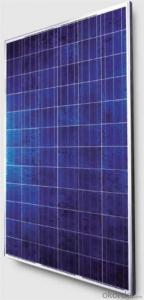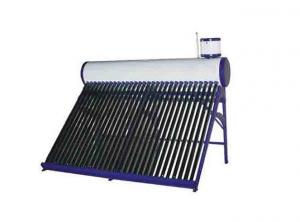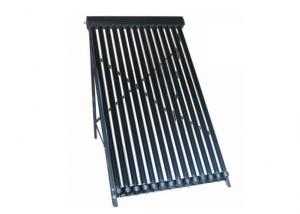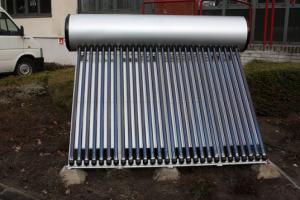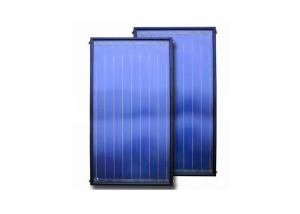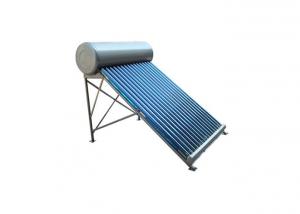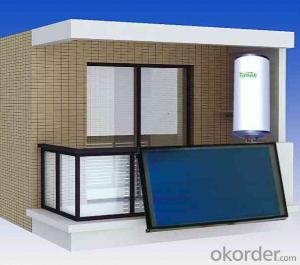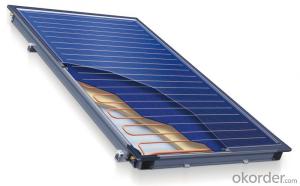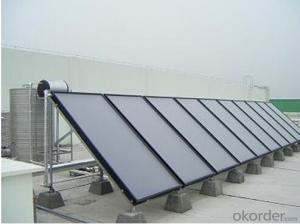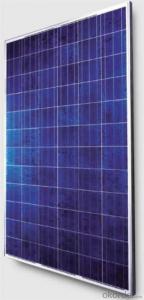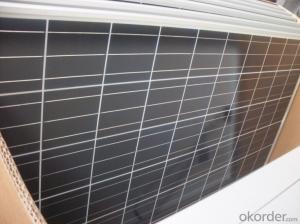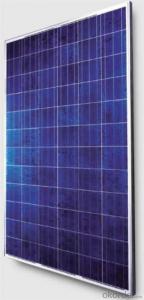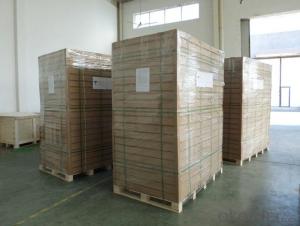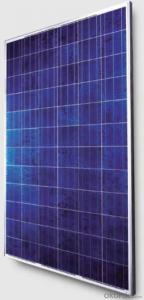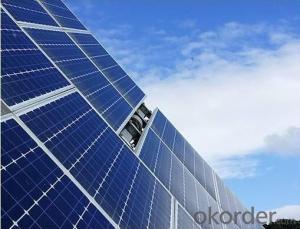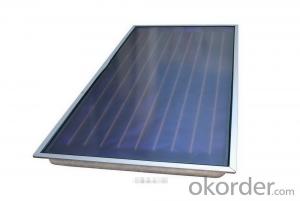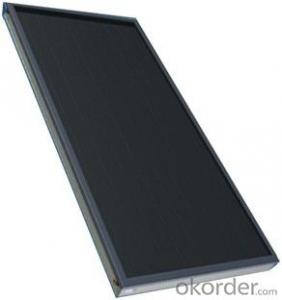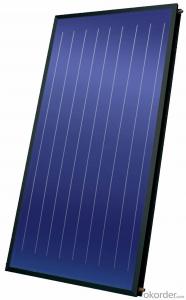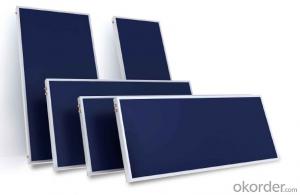Flexible Solar Collectors - CNBM Brand Silicon Modules Made in China
- Loading Port:
- Tianjin
- Payment Terms:
- TT OR LC
- Min Order Qty:
- 1 pallet
- Supply Capability:
- 100000000 pallet/month
OKorder Service Pledge
OKorder Financial Service
You Might Also Like
Solar modules use light energy (photons) from the sun to generate electricity through the photovoltaic effect. The majority of modules use wafer-based crystalline silicon cells or thin-film cells based on cadmium telluride or silicon. The structural (load carrying) member of a module can either be the top layer or the back layer. Cells must also be protected from mechanical damage and moisture. Most solar modules are rigid, but semi-flexible ones are available, based on thin-film cells.

Specifications:
solar panels from 5W--300W, made of TAIWAN MOTECH brand cells,with CO in TAIWAN,Mono and Poly with VDE,IEC,CSA,UL,CE,ISO.
We import solar cells from Taiwan Motech brand, with this CO in taiwan and our CSA certification,we can still sell goods to Anti-dumping areas like USA. Our main products are solar panels, off grid and on grid solar home systems , solar street lighting systems, solar water heating system,solar pump,solar attic fan, solar DC LED lights and solar DC refrigerators.
Certificates : ISO, CE, VDE IEC, MCS, CSA-UL, CEC.
Delivery time: sample 10days, order 25-30days.
Sample: charged.
Payment term: T/T 30% as deposit, 70% before shipment. Or irrevocable L/C at sight.
Trade term: FOB Shenzhen or CIF destination seaport or Airport.
Characteristics:
I.Solar Cell : High efficiency crystalline solar cell. Even if under the weak light, the solar module can produce maximum power output.
II.Tempered glass (toughened glass): Anti-reflecting coating and high transmission rate glass increase the power output and mechanical strength of solar module.
III.EVA and TPT: Using high quality EVA and TPT to prevent destroying and water.
IV.AI frame: Without screw, corner connection. 6 holes on the frame can be installed easily.
V.Junction box: Multi function junction box with water proof.
VI.Long lifetime: ≥25 years; Less power decrease.
VII.Good performance of preventing from atrocious weather such as wind and hails.
VIII.Resisting moisture and etching effectively, not effected by geology.
IX.The certificate issued by international authority: UL, TUV, IEC, VDE, CE.
Quality and Safety
1. Rigorous quality control meets the highest international standards.
2. High-transmissivity low-iron tempered glass, strong aluminium frame.
3. Using UV-resistant silicon.
4. IS09001/14001/CE/TUV/UL
Warranties
1. 10 years limited product warranty
2. 15 years at 90% of the minimal rated power output
3. 25 years at 80% of the minimal rated power output
Technical date :
ITEM NO.: | Poly 156*156 cell ,60pcs . Power range from 230Wp-260Wp | ||||||
Maximum Power(W) | 230 | 235 | 240 | 245 | 250 | 255 | 260 |
Optimum Power Voltage(Vmp) | 29.4 | 29.5 | 29.7 | 30.1 | 30.3 | 30.5 | 30.7 |
Optimum Operatige Current(Imp) | 7.83 | 7.97 | 8.08 | 8.14 | 8.25 | 8.37 | 8.48 |
Open Circuit Voltage(Voc) | 36.7 | 36.8 | 36.9 | 37.1 | 37.3 | 37.5 | 37.7 |
Short Circuit Current(Isc) | 8.52 | 8.59 | 8.62 | 8.65 | 8.69 | 8.73 | 8.78 |
Solar Cell: | 156*156 Poly | ||||||
Number of Cell(pcs) | 6*10 | ||||||
Name of Solar Cells | Polycrystalline Cell | ||||||
Size of Module(mm) | 1650*992*40/45/50 | ||||||
Cable & Connector Type | Pass the TUV Certificate | ||||||
Frame(Material Corners,etc.) | Aluminium-alloy | ||||||
Back sheet | TPT | ||||||
Weight Per Piece(KG) | 19.5KG | ||||||
FF (%) | 70-76% | ||||||
Junction Box Type | Pass the TUV Certificate | ||||||
Tolerance Wattage(e.g.+/-5%) | ±3%, or 0-3% | ||||||
Front Glass Thickness(mm) | 3.2 | ||||||
Temperature Coefficients of Isc(%) | +0.04 | ||||||
Temperature Coefficients of Voc(%) | -0.38 | ||||||
Temperature Coefficients of Pm(%) | -0.47 | ||||||
Temperature Coefficients of Im(%) | +0.04 | ||||||
Temperature Coefficients of Vm(%) | -0.38 | ||||||
Temperature Range | -40°C to +85°C | ||||||
Surface Maximum Load Capacity | 5400Pa | ||||||
Allowable Hail Load | 23m/s ,7.53g | ||||||
Bypass Diode Rating(A) | 12 | ||||||
Warranty | 90% of 10 years, 80% of 25 years. | ||||||
Standard Test Conditions | AM1.5 1000W/ 25 +/-2°C | ||||||
Packing | carton or pallet | ||||||
1*20' | 14 Pallets / 316pcs | ||||||
1*40'STD | 25 Pallets / 700pcs | ||||||
FAQ:
I..Will you focus on the safety of the goods during transportation?
Yes, Safety of the cargo is the primary element that we would consider on transportation.
II..How would guarantee the quality will meet the requirements of your clients?
Before shipment, we will have inspection for each batch of goods.
III..What certificates do you have?
IEC,UL,TUV,CSA,etc.
IV..Can you do OEM according to clients’ requirements?
Yes, we have our own brand while we can provide OEM service.
- Q: Can solar collectors be used in solar thermal desalination?
- Solar thermal desalination can utilize solar collectors to convert seawater or brackish water into fresh drinking water using solar energy. These collectors, such as flat-plate collectors or parabolic troughs, capture and concentrate the sun's energy, which is then used to heat the water and generate steam. The steam is condensed to produce fresh water, while the concentrated brine is disposed of. Solar collectors play a crucial role in the process as they provide the necessary heat energy without relying on fossil fuels or electricity. By harnessing abundant and renewable solar energy, solar collectors make solar thermal desalination an environmentally friendly solution for addressing water scarcity in arid regions.
- Q: What materials are used in solar collectors?
- Solar collectors typically use materials such as glass, metal, and various types of absorber materials to capture and convert sunlight into usable thermal or electrical energy.
- Q: With the tonnage of solar collectors and air to hot water which power consumption
- resulting in no hot water in the rain and snow weather; and air to hot water works relative It is not affected by the sunshine, theoretically can be used throughout the year.
- Q: Can solar collectors be used for heating office buildings?
- Yes, solar collectors can be used for heating office buildings. Solar thermal collectors can capture sunlight and convert it into heat energy, which can then be used to provide space heating for office buildings. This can help reduce the dependence on traditional heating systems and lower energy costs while promoting sustainability.
- Q: Can solar collectors be used in sports stadiums?
- Yes, solar collectors can be used in sports stadiums. They can be installed on rooftops or parking structures to harness the sun's energy and provide electricity for various stadium operations such as lighting, scoreboard systems, heating, and cooling. Additionally, solar collectors can also be used to heat water for showers and other facilities within the stadium complex.
- Q: Can solar collectors be used in agricultural areas?
- Yes, solar collectors can be used in agricultural areas. They can be used to power irrigation systems, provide electricity for farm operations, or heat water for various agricultural processes. Solar collectors are a sustainable and cost-effective solution that can help improve the efficiency and sustainability of agricultural practices.
- Q: Are there any financial incentives for installing solar collectors?
- Yes, there are several financial incentives for installing solar collectors. These include federal tax credits, state and local incentives, grants, and rebates. Additionally, solar collectors can significantly reduce energy bills, providing long-term savings.
- Q: How long do solar collectors typically last?
- Solar collectors typically last for about 20-30 years, although proper maintenance and regular cleaning can extend their lifespan.
- Q: Can solar collectors be used for generating electricity on rooftops in cities?
- Yes, solar collectors can definitely be used for generating electricity on rooftops in cities. Solar collectors, commonly known as solar panels or photovoltaic (PV) panels, are designed to convert sunlight into electricity. They can be installed on rooftops of buildings in cities to harness the abundant solar energy available in urban areas. Solar panels are composed of multiple photovoltaic cells made of materials like silicon. When sunlight hits these cells, it excites the electrons within them, creating a flow of electricity. This electricity can then be used to power various appliances and devices within the building. Rooftop solar installations in cities have several advantages. Firstly, rooftops offer a large surface area that is often unobstructed by shade or other buildings, allowing for optimal exposure to sunlight. Additionally, installing solar panels on rooftops helps to maximize the use of available space in densely populated urban areas where land is limited. Generating electricity through solar collectors on rooftops is a clean and renewable energy solution. It reduces the reliance on fossil fuels and decreases greenhouse gas emissions, contributing to the fight against climate change. Moreover, rooftop solar installations can help cities become more energy independent and resilient, as they generate electricity right where it is needed. Furthermore, solar collectors on rooftops can also have economic benefits. By generating electricity on-site, building owners can reduce their reliance on the grid and lower their energy bills. In some cases, excess electricity generated can be fed back into the grid, allowing building owners to earn credits or revenue through net metering or feed-in tariffs. However, there are also some considerations when installing solar collectors on rooftops in cities. Building codes, structural requirements, and shading issues should be taken into account to ensure the safe and efficient installation of solar panels. Additionally, the initial cost of purchasing and installing solar panels can be a barrier for some building owners, although the long-term financial benefits often outweigh the upfront investment. In conclusion, solar collectors can definitely be used for generating electricity on rooftops in cities. They offer a clean, renewable, and economically viable solution to meet the energy needs of urban areas while reducing environmental impact. With proper planning and installation, rooftop solar installations can be a valuable asset in the transition towards a more sustainable and energy-efficient future.
- Q: Can solar collectors be used in recreational facilities?
- Yes, solar collectors can be used in recreational facilities. They can be installed to harness solar energy and provide heating or hot water for pools, spas, or other recreational amenities. This eco-friendly solution can help reduce energy costs and contribute to a more sustainable operation of the facility.
Send your message to us
Flexible Solar Collectors - CNBM Brand Silicon Modules Made in China
- Loading Port:
- Tianjin
- Payment Terms:
- TT OR LC
- Min Order Qty:
- 1 pallet
- Supply Capability:
- 100000000 pallet/month
OKorder Service Pledge
OKorder Financial Service
Similar products
Hot products
Hot Searches
